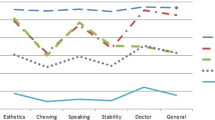Abstract
A number of different factors contribute to an efficient clinical outcome in prosthetic dentistry. Differences between patient’s and prosthodontist’s perception of treatment display great variability. Patient satisfaction in prosthetic dentistry is a multidimensional concept as is patient’s perception of dental care. Patient satisfaction can be assessed if it is carefully defined. In the prosthodontic treatment context patient satisfaction can be expected to interact with the patient’s entire life situation. This article highlights the issues that reflect the different dimensions of patient satisfaction in prosthodontic care.
Similar content being viewed by others
References
De Van MM (1942) Methods of procedure in a diagnostic service to the edentulous patient. J Am Dent Assoc 29:1981–1990
Sondell K, Soderfeldt B, Palmqvist S (2004) The dentist’s communicative role in prosthodontic treatment. Int J Prosthodont 17(6):666–670
Kress GC (1988) Patient satisfaction with dental care. Dent Clin North Am 32(4):791–802
Nermin Y, Ankara T (2005) Dentist patient relationship and quality care 1. Introduction. Int Dent J 55(2):110–112
Grieder A (1973) Psychologic aspects of prosthodontics. J Prosthet Dent 30:736–744
Sondell K, Soderfeldt B, Palmqvist S (1998) A method for communication analysis in prosthodontics. Acta Odontol Scand 56:48–56
Akarslan ZZ, Sadik B, Erten H, Karabulut E (2009) Dental esthetic satisfaction, received and desired dental treatments for improvement of esthetics. Indian J Dent Res 20(2):195–200
Hakestam U, Söderfeldt B, Rydén O, Glantz E, Glantz PO (1997) Dimensions of satisfaction among prosthodontic patients. Eur J Prosthodont Restor Dent 5(3):111–117
Szasz TS, Hollender MH (1956) A contribution to the philosophy of medicine: the basic models of the doctor patient relationship. Arch Intern Med 97:585–592
Barker T (1999) Patient motivation. Dent Update 99:453–457
Goiato CM, Pesqueira AA, da Silva CR, Filho GH, dos Santos DM (2009) Patient satisfaction with maxillofacial prosthesis. Literature review. J Plast Reconstr Aesthet Surg 62(2):175–180
Turkyilmaz I, Company AM, McGlumphy EA (2010) Should edentulous patients be constrained to removable complete dentures? The use of dental implants to improve the quality of life for edentulous patients. Gerodontology 27(1):3–10
Hakestam U, Karlsson T, Söderfeldt B, Rydén O, Glantz PO (1997) Does quality of advanced prosthetic dentistry determine patient satisfaction. Acta Oontol Scand 55:365–371
Newsome PR, Wright GH (1999) A review of patient satisfaction: 2. Dental patient satisfaction: an appraisal of recent literature. Br Dent J 186(4):166–170
Hannah A, Millichamp J, Ayers KM (2004) A communication skills course for undergraduate dental students. J Dent Educ 68(9):970–977
Yoshida T, Milgrom P, Coldwell S (2002) How do US and Canadian dental schools teach interpersonal communication skills? J Dent Educ 66(11):1281–1288
Gale EN, Carlsson SG, Eriksson A, Jontell M (1984) Effects of dentists’ behavior on patients’ attitudes. J Am Dent Assoc 109:444–446
Corah NL, O’Shea RM, Bissell GD (1985) The dentist–patient relationship: perceptions by patients of dentist behavior in relation to satisfaction and anxiety. J Am Dent Assoc 111:443–446
Corah NL, O’Shea RM, Bissell GD, Thines TJ, Mendola P (1988) The dentist patient relationship: perceived dentist behaviors that reduce patient anxiety and increase satisfaction. J Am Dent Assoc 116:73–76
Kulich KR, Berggren U, Hallberg LR (2000) Model of the dentist-patient consultation in a clinic specializing in the treatment of dental phobic patients: a qualitative study. Acta Odontol Scand 8:63–71
Sondell K, Soderfeldt B (1997) Dentist–patient communication: a review of relevant models. Acta Odontol Scand 55:116–126
Dougall A, Fiske J (2008) Access to special care dentistry: Part 2. Communication. Br Dent J 205(11):11–21
Sondell K, Soderfeldt B, Palmqvist S (2002) Dentist–patient communication and patient satisfaction in prosthetic dentistry. Int J Prosthodont 5(1):28–37
Levin RP (2006) Interpersonal communication. J Am Dent Assoc 137:239–240
Levin RP (2008) The interpersonal factor. J Am Dent Assoc 139:986–987
Yamalik N (2005) Dentist patient relationship and quality care 1. Modification of behaviour. Int Dent J 55(6):110–112
Yamalik N (2005) Dentist patient relationship and quality care 2. Trust. Int Dent J 55(3):168–170
Wright R (1988) Improving dentist patient relations. Quintessence Int 29(6):400–401
Bennet ME, Weyant RI, Wallish JM, Greeen G (1995) Dentists’ attitude towards the treatment of HIV positive patients. J Am Dent Assoc 126:509–514
Kunzel C, Sadowsky D (1991) Comparing dentists’ attitude and knowledge concerning AIDS: differences and similarities by locale. J Am Dent Assoc 122:55–61
Bauman GH (1996) The financing and delivery of dental care: a nationwide survey of dentists. J Am Dent Assoc 127:1108–1113
Witter DJ, Allen PF, Wilson NH, Kayser AF (1997) Dentists’ attitude to the shortened dental arch concept. J Oral Rehab 24:143–147
Smith TA, Kroeger RF, Mullins MR (1991) A survey of dentists’ attitude about treating fearful patients. Gen Dent 39:254–256
Luthardt RG, Marré B, Heinecke A, Gerss J, Aggstaller H, Busche E et al (2010) The randomized shortened dental arch study (RaSDA): design and protocol. Trials 19(11):15
Kronström M, Palmqvist S, Söderfeldt B, Carlsson GE (1999) General dentists’ attitudes toward delegation, information, and patient influence in a prosthodontic context. Int J Prosthodont 12(1):45–50
Yamalik N (2005) Dentist patient relationship and quality care 4. Professsional inforamtion and informed consent. Int Dent J 55:342–344
Santoro A, Donno DE, Dell’Erba A, Introna F (2007) Esthetics and implantology: medico-legal aspects. Minerva Stomatol 56(1–2):45–51
Author information
Authors and Affiliations
Corresponding author
Rights and permissions
About this article
Cite this article
Sangappa, S.B. Patient Satisfaction in Prosthodontic Treatment: Multidimensional Paradigm. J Indian Prosthodont Soc 12, 21–26 (2012). https://doi.org/10.1007/s13191-011-0106-5
Received:
Accepted:
Published:
Issue Date:
DOI: https://doi.org/10.1007/s13191-011-0106-5




